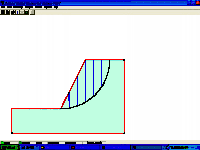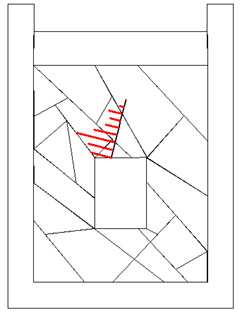
Discontinuous Deformation Analysis
Last modified: Sat Jul 08 08:20:09 Pacific Daylight Time 2006
What is DDA?
Discontinuous Deformation Analysis (DDA) is a numerical method, similar to the finite element method, for solving stress-displacement problems, but for a jointed rock mass. DDA uses an implicit algorithm for simultaneous solution of the equations of equilibrium by minimizing the total potential energy of the blocky rock mass system. The relation between adjacent blocks is governed by equations of contact interpenetration and accounts for friction. DDA adopts a stepwise approach to solve for the large displacements that accompany discontinuous movements between blocks. The blocks are said to be "simply deformable". Since the method accounts for the inertial forces of the blocks' mass, it can be used to solve the full dynamic problem of block motion.
Using DDA
DDA was originally presented as a complete methodology for numerically modeling discontinuous rock mass behavior. Because the behavior of fractured rock masses is largely controlled by the geometry of the fracture system, fracture geometry pre-processing is integral part of an analysis. DDA for Windows currently accepts lists of fractures and reduces the fractures to a block system. All this geometry adds complexity for the user as well as the programmer. The end result is that even in the Windows versions, DDA should be considered at least as complex as the average finite element code, with additional considerations for fracture geometry, plus all the difficulties common to any particle code (i.e., contact mechanics, etc.).
Featured project
DDA has been used for a wide variety of engineering analyses. We are in the process of distilling some of the most interesting and relevant projects employing DDA to illustrate the elegance if discrete element modeling using DDA.
Cable bolting in DDA


(a) (b)
Axial load along the cable bolt that installed at
roof of
underground excavation: (a) without plate and (b)
with plate (M. Moosavi, R.
Grayeli).